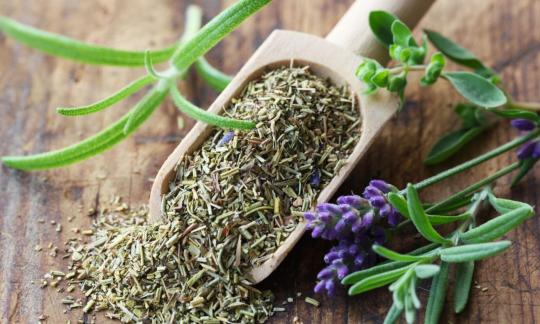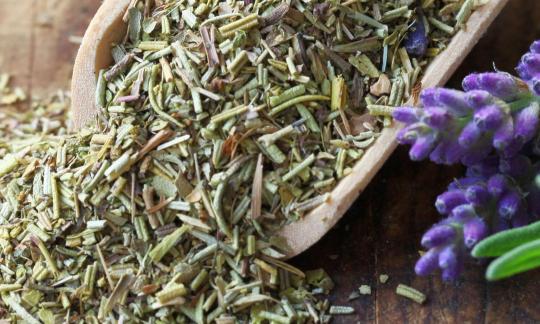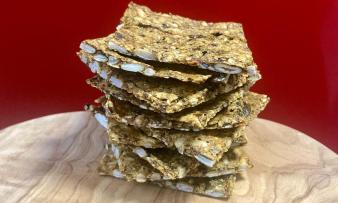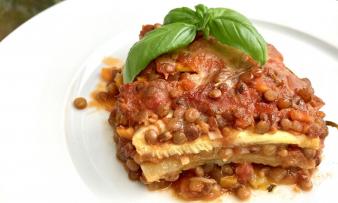Table of contents
Herbs of Provence (Herbes de Provence) are mainly used for French dishes. However, the organic herb mixture also goes well with other Mediterranean dishes.
Use in the kitchen
The mixture from Provence consists of various herbs that grow wild in the south of France. It can be composed in different ways, but thyme, rosemary, oregano and savory are usually used. Lavender flowers and marjoram are often added. Occasionally basil, tarragon, fennel seeds, chervil, bay leaves or juniper berries are also added. Lovage, parsley and sage are less commonly found in the herb mixture.
Herbs de Provence go well with dishes such as ratatouille, zucchini lasagna with lentils or in a vegan moussaka. They also taste delicious in tomato sauce, with baked potatoes, in bean stew or mushroom ragout and in vegetable casseroles. You can also season salty baked goods or rolls with the herb mixture. You can easily make a herb dip from them by mixing them with soy yoghurt and a little lemon juice.
For desserts, the mixture is traditionally used to make spiced honey cookies. You can also put the herbs on grilled peaches and nectarines, drizzle them with agave syrup and serve them with ice cream or frozen coconut yoghurt as a summer fruit dessert.
Preparing your own herbs from Provence
Can you mix herbs from Provence yourself? You can easily put together your own mixture. This allows you to influence the taste and the degree of grinding of the individual herbs yourself. It is best to use dried organic herbs, as these are not contaminated with pesticides. You can buy the herbs individually or dry them yourself from fresh herbs from your own garden, etc. You can find out how best to dry herbs under the link to dried thyme.
The traditional basic mixture consists of thyme, rosemary, oregano and savory. The herbs are usually used in equal parts or according to taste. The herbs can be easily crushed in a mortar. The mixture can be supplemented with lavender flowers, marjoram and other herbs.
You can use the Herbs of Provence mixture as a base for your own herb mixtures and supplement it with, for example, dried lemon peel, onions or garlic.
Vegan recipe for ratatouille with herbs de Provence
Ingredients (for 4 people): 1 eggplant, 2 zucchini, 2 sweet peppers, 2 red onions, 2 cloves of garlic, 1 tbsp rapeseed oil, 500 g tomatoes, 250 ml water, 2 tsp herbs de Provence, salt andblack pepper.
Preparation: Wash the eggplant, zucchini and sweet peppers. Remove the stems and seeds from the sweet peppers. Cut the ends off the zucchini and eggplant and cut them into bite-sized pieces together with the sweet peppers. Peel the onions and garlic. Finely chop the onions and sauté with oil in a large pan over medium heat. After about 5 minutes, press in the garlic and then add the vegetables. Sauté everything together for about 5 minutes, stirring occasionally. Wash the tomatoes and cut into cubes. Add to the vegetables together with the herbs de Provence and water and mix everything well. Cover and simmer for at least 20 minutes. Season the ratatouille with salt and black pepper before serving.
Vegan recipes with "Herbs de Provence" can be found under the note: " Recipes that have the most of this ingredient ".
| Not only vegans or vegetarians should read this: Vegans often eat unhealthily. Avoidable nutritional mistakes. |
Purchasing - Storage
Major retailers such as Coop, Migros, Spar, Aldi, Lidl, Rewe, Hofer, Edeka and Billa have herbs from Provence in their range, some of them in organic quality. You can also buy herbs from Provence in health food stores and organic supermarkets such as Denn's Biomarkt and Alnatura. Denner and Volg do not have them in their standard range. The mixtures have different compositions, which is why you should pay attention to the product's list of ingredients. Contrary to the name, the herbal mixture rarely comes from France.
The availability of the "Herbs of Provence" mix varies depending on the size of the store, catchment area, etc. If you are interested, click on our recorded food prices for the DA-CH countries (above under the ingredient image). There you will find current prices and, by clicking, their development at various suppliers.
Storage tips
Dried herbs should be stored in glass or metal containers, protected from light and moisture. Plastic containers should be avoided for storage, as plastic can absorb the essential oil and affect the taste.
Ingredients - Nutritional values - Calories
Here we realistically show you the ingredients of spices and herbs per 1 g (instead of per 100 g as usual).
The ingredients vary depending on the composition of the herbal mixture.
1 g of Herbs de Provence (raw) has a calorie content of 3.37 kcal. It contains 0.63 g carbohydrates, 0.09 g protein and 0.09 g fat. 1
The herbal mixture provides large amounts of manganese, vitamin K and iron. 1
1 g of herbs contains 0.07 mg of manganese and 2.57 µg of vitamin K. This corresponds to 3.7% and 3.4% of the daily requirement of the corresponding nutrients. Parsley and basil provide slightly more manganese with 0.09 mg/1g. Thyme (17.14 µg/1g) and wild garlic (26.25 µg/1g) contain particularly high levels of vitamin K.
1 g of Herbs de Provence provides 0.39 mg/1g of iron, which corresponds to 2.81% of the daily requirement. Even more iron is contained in marjoram (0.83 mg), basil (0.90 mg) and thyme (1.24 mg). 1
The complete ingredients of "Herbs of Provence", the coverage of the daily requirement and comparison values with other ingredients can be found in our nutrient tables. In the article Nutrients explained you will get a detailed insight into the topic.
Health effects
The herbs of Provence are rich in essential oils that can have a positive effect on health. Thyme, oregano and savory mainly contain thymol and carvacrol. 5,6,7,8 Rosemary, on the other hand, mainly contains borneol, camphor and cineole. 9,10
In vitro studies show that oregano, thyme and rosemary have antioxidant, antimicrobial and antibacterial effects. In addition, these herbs, like winter savory, have an expectorant effect. This is why they are often used to treat coughs, bronchitis and colds. 5,7,11,12
Thyme and rosemary also have an antispasmodic effect and rosemary is slightly analgesic, which is why it can be used for menstrual pain. Winter savory is also used for menstrual cramps. 5,7,11,12,13
Dangers - Intolerances - Side effects
The consumption of herbs rarely triggers allergic reactions. Excessive consumption of "Herbs de Provence" should be avoided during pregnancy. However, the occasional seasoning of food is generally not a problem.
Ecological footprint - animal welfare
The ecological CO 2 footprint of the herb mixture "Herbs of Provence" depends on several factors, including the way the herbs are grown, the country of origin and the corresponding transport, processing and packaging. Despite extensive research, we were unable to find any precise information on the ecological footprint of the herb mixture. For oregano from organic farming, for example, one study found an emission level of 0.069 kg CO 2 eq/kg, and for organic rosemary 0.051 kg CO 2 eq/kg. These values increase for herbs from conventional cultivation due to the synthetic fertilizers and pesticides used.xx
Despite extensive research, we have not yet found any significant information/data/figures on the ecological footprint of these herbs.
Worldwide occurrence - cultivation
Herbs of Provence is not a traditional mixture and is not legally protected. It has neither a "protected geographical indication" nor a "protected designation of origin" under EU law (as of 2023). The herbs therefore do not necessarily have to come from Provence (France). 3
Industrial production
In commercial production, sieves or blowers clean the herbs of sand, earth and stones. Then special mills mechanically crush the herbs. In industry, the majority of herbs are dried using hot air in special ovens or on belts. In freeze-drying, the herbs are shock-cooled to -18 °C using liquid nitrogen. In a vacuum, the ice that is created turns directly into a gaseous state (water vapor) and can be easily sucked out. This technique is more expensive, but ensures that the herbs retain their structure, natural color and flavor even over longer storage periods. 2
Herbs are sometimes contaminated with germs that can be harmful to health or reduce their shelf life. These are therefore removed using special steam and heat disinfection processes. Treatment with ionizing radiation is permitted within the EU. This method is not used in every EU country and some countries only import non-irradiated goods. 2
Further information
Since 2003, Herbs of Provence have been available under the Label Rouge quality seal. This confirms that the herbs come from France and must have a certain composition, namely 19% thyme, 27% rosemary, 27% savory and 27% oregano. 4
Alternative names
Herbs of Provence are called "herbes de provence" in French. The English name is "Herbs of Provence".
Other uses
The Herbs of Provence mixture is also used to make soaps, scented oils and bath additives. The herbal mixture can sometimes be found preserved in oil or vinegar.
Bibliography - 13 Sources
| 1. | ÖNWT Die österreichische Nährwerttabelle. Kräuter der Provence Gewürzmischung (ÖNWT-PRO R201L00). |
| 2. | Bundeszentrum für Ernährung. Kräuter Verarbeitung. |
| 3. | eAmbrosia. The EU geographical indications register. |
| 4. | Taste France Magazine. Herbes de Provence Label Rouge. |
| 5. | Bown, Deni: Kräuter. Die grosse Enzyklopädie. Anbau und Verwendung. 2. Auflage (2015); Dorling Kindersly Verlag GmbH. München. |
| 6. | Nostro, A et al: Effects of oregano, carvacrol and thymol on Staphylococcus aureus and Staphylococcus epidermidis biofilms. Journal of Medical Microbiology (2007), 56;519–523 DOI 10.1099/jmm.0.46804-0 |
| 7. | Salehi B, Mishra AP, Shukla I, Sharifi-Rad M, Contreras MDM, Segura-Carretero A, Fathi H, Nasrabadi NN, Kobarfard F, Sharifi-Rad J. Thymol, thyme, and other plant sources: Health and potential uses. Phytother Res. 2018 Sep;32(9):1688-1706. |
| 8. | Lombrea A, Antal D, Ardelean F, Avram S, Pavel IZ, Vlaia L, Mut AM, Diaconeasa Z, Dehelean CA, Soica C, Danciu C. A Recent Insight Regarding the Phytochemistry and Bioactivity of Origanum vulgare L. Essential Oil. Int J Mol Sci. 2020 Dec 17;21(24):9653. |
| 9. | Pahlow M. Das grosse Buch der Heilpflanzen. Gesund durch die Heilkräfte der Natur. 8. Auflage. Hamburg; 2013. Nikol Verlagsgesellschaft mbH & Co. KG. |
| 10. | Niederegger O, Mayr C. Heilpflanzen der Alpen. Gesundheit aus der Natur von A bis Z. Innsbruck; 2006. Tyrolia-Verlag. |
| 11. | Blaschek W. (Herausgeber). Wichtl – Teedrogen und Phytopharmaka. Ein Handbuch für die Praxis. 6. Auflage. Stuttgart; 2016. Wissenschaftliche Verlagsgesellschaft mbH. |
| 12. | Schilcher H, Kammerer S, Wegener T. Leitfaden Phytotherapie. 3. Auflage. München; 2007. Elsevier GmbH. |
| 13. | Hammoudi Halat D, Krayem M, Khaled S, Younes S. A Focused Insight into Thyme: Biological, Chemical, and Therapeutic Properties of an Indigenous Mediterranean Herb. Nutrients. 2022 May 18;14(10):2104. |












Comments